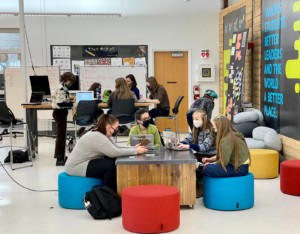4 Tiers Of Showcasing Student Work

In my last year of being a high school principal, I was reminded once again about the power of taking student work public. Then high school senior Destiny Anger – who later graduated from UC Santa Cruz and is now a Customer Relationship Manager and Marketing Specialist in the San Francisco Bay Area – used social media showcasing of her senior project to alter the trajectory of her career. As part of her senior project, Anger partnered with Helping Orphans Worldwide on a local awareness project. She was eventually connected to key organizational leaders in New York through a video she posted on her personal Facebook. The video had spread to her school’s Facebook page, and then onto Helping Orphans Worldwide Facebook page. Destiny’s story is not unique. However, it does depend on how much our schools use digital spaces and other public channels to showcase student work.
Students need to have their work assessed, critiqued, evaluated, appreciated, and experienced by as many people as possible including teachers, peers, school leaders, parents, business partners, community members, specific career professionals, and experts. The more we showcase student work, the more students care about producing high-quality work. This process is key in increasing student agency, metacognitive practices, and authentic career preparation. Here are four tiers of taking student work public:
Showcases and Exhibitions
These are events designed to share student work publicly. They are opportunities for students to defend and explain their learning in a professional, reflective, and celebratory environment. Ideally, these should be school-wide or even district-wide. However, it’s perfectly acceptable to organize smaller or more intimate events based on student, staff, and school interests and capacities. Even a single teacher or class can host a public event to showcase student learning. Students, teachers, schools, and/or districts can even participate in showcase events organized by other entities such as business, industry, community agencies, higher education, county offices, or others.
Piggybacking On Existing Events
Although events designed to showcase student work are fantastic and well worth it. We can also take students and their work to existing events. The advantages here are that we already have an existing or captive audience we can optimize or maximize. And, we don’t have to necessarily market or promote it as a showcase. Think about school events – sports, open houses, back-to-school nights, meetings, fundraisers – that we can add the student work component to as an add on. Take this show on the road to school board meetings, city council meetings, industry or business events, and more. Disadvantages are that the audience is attending expecting or anticipating to engage in student work. But it’s a start and can expand the audience.
Digital Spaces
This is the unlimited world to showcase student work globally. There will always be value in face-to-face exhibitions. However, the digital spaces not only allow for larger audience reach but also adds to the development and refinement of the digital portfolio.
Before we get into sharing student work online, let’s not forget digital ways to showcase locally. Most schools now have video monitors or information walls installed on campus. In addition to being information boards, they can be a place to exhibit student work such as presentations, videos, photos, logos, podcasts, art, and much more.
In terms of the online public spaces, there are many. First, we need to make sure that student work appears on all class, school, and district websites. It’s amazing to me that most schools and districts have almost everything online except for student work. When it comes to websites, there are other opportunities as well. Many of our business partners have websites where we could partner and feature student work.
Social Media is a great opportunity to showcase student learning. This can be on a teacher’s social media site, as well as a school district or others. Again, our community partners all use social media and would benefit from showcasing that partnership through sharing student work. And for secondary students, we have the opportunity to teach them and model for them how social media can be used professionally. We are aware of the negative pitfalls of social media. However, organizations such as Common Sense, Edutopia, The Edvocate, and Medium have all addressed how to use social media in education.
This also applies to video channels such as YouTube, Vimeo, and others. Again, we can post student work on a teacher, school site, or even district video channels, as well as those of our partners when relevant. For secondary students, again we can consider students having their own video channel in order to showcase their own work and projects.
This really leads ultimately to students all having their own digital portfolios. Entities such as MorWeb, Website Planet, and ColorLib have compiled specific lists of free website builders for students, teachers, and schools. Students can easily create their own websites and digital portfolios as an ongoing mechanism to showcase work and increase their personal brand equity.
Contests, Competitions
An interesting opportunity to take student work public exists in entering competitions. There are literally thousands of local, regional, national, and even international contests where students can enter their projects. These contests include diverse areas of study such as writing, digital media, visual and performing arts, STEM, career technical education, service learning, and more. Several entities such as We Are Teachers, World Scholarship Forum and Institute of Competition Sciences have worked to compile many of the available contests and competitions. Some are also local and regional and sponsored by county offices of education, local higher ed. institutions, or even business or industry partners. And there is no reason why individual teachers, schools, or districts cannot create their own contests and competitions. All of this is not about trying to necessarily force students into competitive situations. However, it’s one more authentic and real-world place to showcase student work and model that we all have to take the risk of going public.
The Wrap
If teachers and schools focus on this as a priority, they can, along with students, continually evolve new ways to maximize one’s community and technology in order to get all our students’ seen by as many audiences as possible. In keeping with the intent behind deeper learning pedagogies, teachers and schools can ask students for other ways to showcase their work as well.
For more, see:
- 8 Reasons Why Students Should Share Their Work
- 3 Ways to Help Students Become Better Digital Citizens–Today
- Every Student Should Have A Digital Portfolio
Stay in-the-know with innovations in learning by signing up for the weekly Smart Update.








aditi
hi, thanks for sharing this amazing post